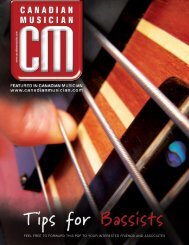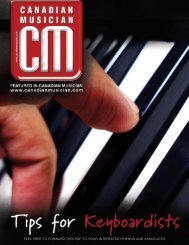Download (PDF) - Canadian Musician
Download (PDF) - Canadian Musician
Download (PDF) - Canadian Musician
You also want an ePaper? Increase the reach of your titles
YUMPU automatically turns print PDFs into web optimized ePapers that Google loves.
Musical Grids For Improvisers Part II<br />
by Bill McBirnie<br />
woodwinds<br />
A Couple of Illustrations<br />
Think back to the worst improvised solos you have<br />
ever heard and, by reference to the Relaxation/Tension<br />
grid (from March/April CM), consider why they<br />
struck you as being so bad. You will likely find that<br />
the soloist was working one side of the grid only! Indeed,<br />
in the worst case you can possibly think of, I’ll bet that the<br />
soloist was resorting almost exclusively to the elements set<br />
out in the right side of the grid – and all in a vain effort to<br />
create “interest.”<br />
This is why I stress the importance of relying on relaxation<br />
as a point of reference in your improvising. Only invoke tension<br />
as a means of creating balance and sustaining interest<br />
– from time to time – and generally not as an end in itself.<br />
With the proper focus and direction, you can structure your<br />
solo such that there is a logical sequence and development<br />
that typically (though not necessarily) unfolds as follows:<br />
Relaxation – Tension – Relaxation.<br />
Miles Davis is<br />
often cited for his<br />
remarkable use of<br />
space. Indeed, his<br />
“silences” often<br />
make his “noises”<br />
speak with formidable<br />
eloquence.<br />
Ultimately, the<br />
fascination, the<br />
appeal, indeed,<br />
the very mystery<br />
of Miles is a direct<br />
function of<br />
his well-grounded<br />
sense and astute<br />
application of<br />
these very basic<br />
musical elements.<br />
There are many<br />
examples of this all-encompassing aspect of Miles’ work<br />
but, to cite just a few, let me suggest E.S.P., Sorcerer, Miles<br />
Smiles, and Neffertiti (all on Columbia records).<br />
When John Coltrane developed his “sheets of sound,”<br />
he quite deliberately played lines of unrelenting motion at<br />
staggering speeds. For Trane, this relentless speed served<br />
as a point of consonance (or relaxation, if you will) with the<br />
unusual consequence that his slow and more restful passages<br />
became points of relative dissonance (or tension). Indeed,<br />
what Trane did with his “sheets of sound” approach was to<br />
turn the Relaxation/Tension grid on its head and then sort<br />
of twist it all around. There are many examples to illustrate<br />
this particular facet of Trane’s work. However, I will cite just<br />
one here: Black Pearls (on Prestige records).<br />
The Structural Level<br />
As I indicated earlier, the basic elements of music can be<br />
examined both on a performance (i.e., a non-technical) and<br />
on a structural (i.e., a technical) level. Let’s turn to the structural<br />
level now.<br />
Some of the basic elements of structure that serve as<br />
sources of consonance and dissonance are set out below.<br />
These elements are technical in nature and they will likely<br />
be a little more difficult to follow. Nonetheless, read them<br />
slowly and carefully … and think about them. Then start to<br />
listen for these structural elements in the work of musicians<br />
whom you admire and observe how they utilize and exploit<br />
these structural elements (and how, in some cases, they mix<br />
and match these structural elements). Ultimately, try to utilize<br />
these same devices in your own improvised solos in a<br />
meaningful and balanced manner.<br />
Sources Of Consonance<br />
Sources Of Dissonance<br />
Diatonic<br />
Atonal<br />
In Time<br />
Out of Time<br />
Down Beats<br />
Up Beats<br />
Scales<br />
Arpeggios<br />
Small Intervals<br />
Big Intervals<br />
Thirds, Sixths, Fourths, & Fifths Seconds, Sevenths, Altered<br />
Fourths, & Altered Fifths<br />
Root Movements In 4ths & 5ths Root Movements In Other<br />
Intervals<br />
Major/Minor/Pentatonic Tonalities Dominant/Diminished/<br />
Augmented Tonalities<br />
Simple Chord Structures (e.g., Triads) Complex Chord Structures<br />
(e.g., With Extensions,<br />
Alterations, & Substitutions)<br />
Within The Tonality<br />
Without/Against the<br />
Tonality<br />
Asymmetrical Structures<br />
Symmetrical Structures<br />
Non-Sequential Arrangements<br />
Modal & Chanting Formats<br />
Sequential Arrangements<br />
Through Composed<br />
Melodies with Rapidly Shifting<br />
Harmonies<br />
Once you become more aware of these contrasting elements,<br />
explore the many ways in which these elements can<br />
be combined – and re-combined. Then try to utilize those<br />
combinations and re-combinations as sensitively as you can<br />
when improvising (being mindful of the context in which you<br />
are playing, of course).<br />
In summary, relaxation and consonance will serve to anchor<br />
your solo while tension and dissonance will serve to create<br />
interest and propel your solo forward. If you can manage to<br />
balance these contrasting elements (based on the two grids<br />
above) in a sensitive and thoughtful manner, then you will<br />
experience a much greater likelihood of producing pleasing<br />
– and musical – results in your improvising.<br />
Bill McBirnie is a jazz and Latin flute specialist located in Toronto<br />
who has been chosen Flutist of the Year by the Jazz Report Awards,<br />
nominated as Instrumentalist of the Year at the National Jazz Awards,<br />
and declared a winner of the US National Flute Association’s triennial<br />
Jazz Flute Masterclass Competition. He has produced several Extreme<br />
Flute projects to date including his most recent, Paco Paco, with Bernie<br />
Senensky (piano), Neil Swainson (bass), and John Sumner (drums). All<br />
of these are available from the distributor Indie Pool at indiepool.com. If<br />
you would like to contact Bill directly, you can reach him at<br />
billmcb@idirect.com.





